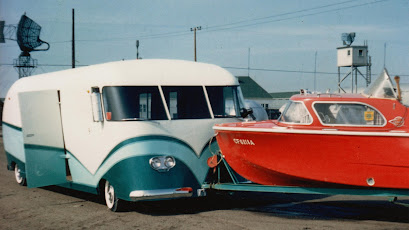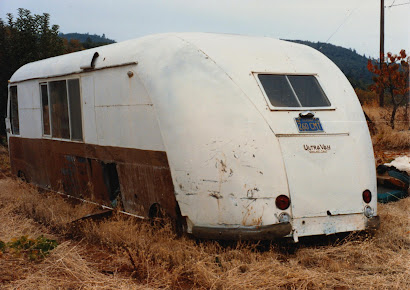To build the first UltraVan that was actually intended for a customer, Dave Peterson hired a local high school student named Lloyd Cerruti. #103 is 24 feet long and features Ford Econoline headlights, Ford Falcon taillights, Chevy pickup bumpers, and ornamental dually rear wheels. Externally, it very closely matches the Demo Van except for the shape of the front wheel arches and the absence of rocker panel trim strakes and tow hitches.
Dr. Stan J. Watson of Walnut Creek CA took delivery of the coach in the summer of 1962, paying $9,500. Four years later he offered it for sale at $6,950. Photos in the UVMCC Archive show #103 at Death Valley and Donner Pass in 1967 (owner J.W. Wells of Brentwood CA), and at the Lion Country Safari UltraVan rally in January 1971 (owners Charles & Florence Harris of Granada Hills CA).
When the third UltraVan's fourth owner decided to upgrade to a V8 engine in 1972, he didn't copy the V-drive configuration that Ultra, Inc. used in 1969-70, or the RWD Toronado configuration that Dave Peterson used in 1970-1971, or even the offset differential configuration that Peterson developed in 1971-72. Instead he used the Corvair hot-rodders technique of mounting a 283 cu. in. small block Chevy V8 engine directly to the Corvair drivetrain, using one of the bellhousing adapters that were produced by companies like Deco, Kelmark, Kennedy Engineered Products, and MID-Engineering. This also required a reversing kit to make the normally clockwise-turning V8 engine run backwards.
The conversion was publicly unveiled at the January 1973 Tecopa Hot Springs rally by owners Aubrey & Wanda Jackson of Glendale CA. UltraVans #361 and #374 have also been converted to the same configuration, but it is not clear which came first or last.
The conversion was publicly unveiled at the January 1973 Tecopa Hot Springs rally by owners Aubrey & Wanda Jackson of Glendale CA. UltraVans #361 and #374 have also been converted to the same configuration, but it is not clear which came first or last.
Don & Marilyn Beattie of Mission Hills CA owned the coach from 1981-1998; eventually selling to Eddie Davidson for $100. Eddie owned the coach only a few months, selling in early 1998 to current owner Nick Riepe of Big Bear CA. Nick lived in the coach for about three years, during which time the coach was used in the filming of the 1999 movie "Five Aces" starring Charlie Sheen. http://www.imdb.com/title/tt0203503/
In the movie, Chris (Charlie Sheen) returns to his hometown of Big Bear California where his old buddies are throwing him a bachelor party. One of these friends is Ray (David Sherrill), who has become a hermit - living in the UltraVan in a remote area next to Baldwin lake, and driving visitors away with an antique Howitzer artillery gun. Chris' ex-girlfriend Lauren (Elizabeth Morehead) also appears in scenes set inside the UltraVan.
Nick says he could hear the film crew shooting off the Howitzer while he was at work 10 miles away in Big Bear. He also says "At the time of filming, Twinkie was my home and they paid me extra per day for a hotel room. After filming I was able to afford registration and insurance. My friends and I had a blast driving it to Big Bear lake to fish for catfish at night. We would watch our poles through the windshield."
After more than 20 years of ownership, Nick and his wife Shonna are thinking about finding the right ambitious UltraVan fan that has the time and funding to restore their beloved Twinkie. Nick says:
"Top speed about 55 mph. But it gets there quick with 283 on Corvair transaxle. Never had an overheat issue, but I only drove it around town up here. Twinkie needs to go to the right person or I won't let go of her. I think she is special. Although all the UltraVans are special. I think since she is a Cali native she probably should stay in CA except for trips. She has her California black and yellow plate front and rear. She does not have an UltraVan badge, which would be cool, does have a book documenting engine replacement and past owners and manual."
A collection of photos of #103 can be seen here:
















